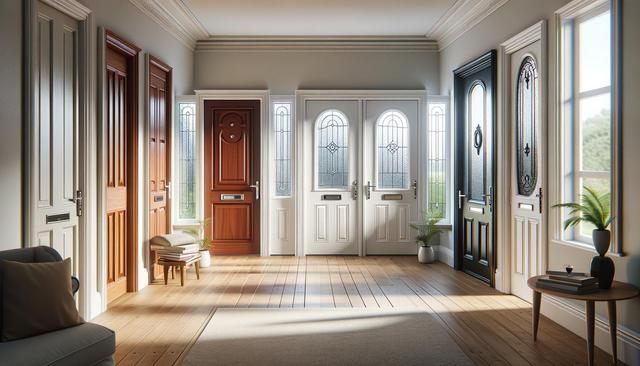A Guide to Front Door Styles and Pricing Options
Front doors are crucial for a home’s security, insulation, and curb appeal. Materials like wood, fiberglass, or steel offer diverse aesthetics and durability. Choosing a style, color, and hardware that complements the house’s architecture significantly enhances its welcoming appearance and overall value.

Popular Front Door Styles to Consider
Front doors have evolved far beyond simple entry points. Today, homeowners can choose from a wide variety of styles that reflect different architectural tastes and practical needs. The most common front door styles include traditional paneled doors, modern flush doors, and craftsman-style doors. Each style brings unique design elements and functional benefits.
Traditional paneled doors are known for their symmetrical patterns and classic appeal. These are often seen in colonial or Georgian-style homes. Craftsman doors, on the other hand, feature straight lines, glass inserts, and wood detailing, making them suitable for bungalow and rustic homes. Modern doors typically have a more minimalist design, using materials like glass and steel to create sleek finishes and geometric shapes.
Some other notable styles include:
- Arched doors – add a touch of elegance and are often used in Mediterranean or Spanish-style homes.
- Double doors – provide a grand entrance and are suitable for larger entryways.
- Dutch doors – split horizontally and allow the top half to open independently, bringing in light and air.
Choosing the right style depends on the overall design of the home and the desired level of visibility, lighting, and privacy.
Materials and Their Characteristics
The material of a front door plays a significant role in its durability, maintenance needs, and energy efficiency. The three most commonly used materials are wood, fiberglass, and steel, each with its own set of advantages and limitations.
Wood remains a popular choice for its natural beauty and ability to be customized. It can be carved, stained, or painted to match any architectural theme. However, wood doors require regular maintenance to protect against moisture and warping.
Fiberglass doors are celebrated for their strength, low maintenance, and energy efficiency. They can mimic the appearance of wood while resisting dents, rust, and rot. Steel doors, meanwhile, offer superior security and are typically more affordable, but they can be prone to dents and may require periodic repainting to prevent rust.
Some additional material options include:
- Glass – often used in combination with other materials for decorative inserts or full panels.
- Aluminum – lightweight and resistant to corrosion, often used in modern designs.
Each material offers different benefits, so homeowners should consider their climate, desired aesthetics, and budget when making a selection.
Color and Finish Options
The color of a front door is not just a design choice—it also influences curb appeal and can even affect resale value. Bold colors like red, navy, or yellow can make a strong statement, while neutral tones such as black, gray, or white offer timeless elegance.
Finishes can vary from matte to high-gloss, and homeowners can choose between painted or stained doors depending on the material. Wood doors are often stained to showcase their grain, while fiberglass and steel options are typically painted. Some manufacturers also offer factory-applied finishes that require less maintenance over time.
When selecting a color or finish, consider:
- The home’s exterior color and materials
- Local climate conditions, which can affect paint durability
- Personal style and how much of a design statement you want the door to make
Color and finish not only impact the door’s appearance but also contribute to its longevity and wear resistance.
Hardware and Accessory Features
Beyond the door itself, hardware and accessories add both functionality and style. Handles, locks, knockers, and hinges are available in various finishes such as brushed nickel, bronze, black, and chrome.
Security features are a top consideration. Multi-point locking systems, smart locks, and reinforced strike plates can enhance the door’s protective qualities. Some doors come pre-fitted with advanced locking mechanisms, while others allow for customization.
Here are a few hardware accessories to consider:
- Door viewers or peepholes for additional visibility
- Decorative kickplates to protect the bottom of the door
- Weather stripping and thresholds for improved insulation
Matching the hardware with the door’s overall design ensures a cohesive look. Additionally, well-chosen accessories can improve ease of use and contribute to a safer, more efficient front entry system.
Price Ranges and Budget Planning
Front door prices vary widely depending on style, material, size, and included features. An entry-level steel door without glass or advanced locking systems might start around a few hundred dollars, while custom wood or ornate fiberglass doors can reach several thousand dollars.
To better understand the typical costs, here’s a general breakdown:
- Steel doors: $200–$700
- Fiberglass doors: $400–$2,000
- Wood doors: $600–$3,000+
- Custom or designer doors: $2,000–$10,000+
It’s important to account for installation costs as well, which can range from $150 to over $1,000 depending on the complexity and region. Homeowners may also want to budget for additional features like sidelights, transoms, or smart technology integration.
When planning your budget, consider the long-term value. Investing in a durable, energy-efficient door can lead to savings on heating and cooling over time, while also enhancing home security and resale appeal.
Conclusion: Making an Informed Front Door Choice
Choosing the right front door is a balance between aesthetic preference, functional needs, and available budget. With so many styles, materials, and features to explore, homeowners can find a door that not only enhances their home’s exterior but also provides comfort, safety, and efficiency. Whether upgrading for curb appeal or replacing a worn-out entryway, understanding the options available makes the process smoother and more rewarding.